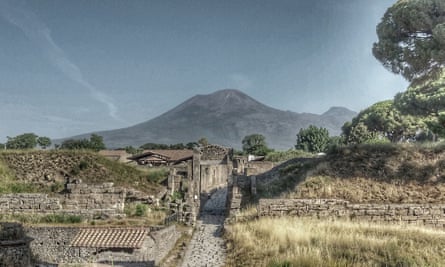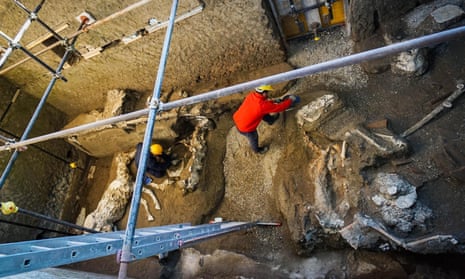It is one of the most ambitious archaeological missions ever undertaken. The Great Pompeii Project promises remarkable discoveries about life in the Roman empire, including the genetic profiles of the town’s inhabitants, their dining preferences, occupations and health.
But as layers of volcanic rock are chipped away to uncover the secrets that lie below, not everyone is celebrating. Volcanologists say the excavation risks destroying clues about the AD79 eruption that could be crucial for protecting the 600,000 people who live in the shadow of Vesuvius today.
After years of simmering tensions, a row has broken out between the two scientific factions, and volcanologists published an open letter in the journal Nature this month criticising the “alarming” destruction of volcanic deposits.
“They seem not to realise that the enthusiasm for archaeology is committing an act of vandalism to volcanology,” said Roberto Scandone, a professor of volcanology at the Roma Tre University. “Leaving some of the deposits in place is valuable not only for scientists but also for visitors, who will be able to see at first hand how the volcano destroyed the town.”
Archaeologists say they are collaborating with volcanologists at the University of Naples and point out there is plenty more volcanic rock for earth scientists to work on beyond the zone of archaeological interest.
The Great Pompeii Project, which was launched in 2012, is a €105m (£94m) effort by the Italian government and the EU to preserve the site, which had descended into a dangerous state, and make new scientific and historical discoveries. It is expanding excavations across the one-third of the Unesco world heritage site yet to be uncovered.
DNA profiles of the Vesuvius’s victims are giving new insights into the ethnic diversity of Roman Pompeii. Samples are being taken of 2,000 sample remains of food, and medical scans will provide a picture of the community’s health.

However, Christopher Kilburn, an earth scientist at University College London, believes the reason Pompeii has become a town synonymous with catastrophe has been sidelined. “There’s a sense of frustration that volcanology is not being taken terribly seriously,” he said. “You go to Pompeii and there’s virtually no mention of the volcano at all.”
According to Kilburn, scientists have been barred from accessing certain areas for health and safety reasons. “But when something interesting is found, all the TV crews and media were there,” he said. “It seems it wasn’t dangerous to them but was dangerous to the professional volcanologists.”
Kilburn said preserving rock at inhabited sites was important to help reconstruct the violent passage of pyroclastic flows, currents of hot gas and volcanic matter that swept through Pompeii.
“Today we hope to use the archaeology to understand the details of how real pyroclastic flows sweep around real buildings, in order to improve methods of protecting future populations not only on Vesuvius but at similar volcanoes around the world,” he said.
Vesuvius is dormant and expected to reawaken at some point.
A spokeswoman for the Archaeological Park of Pompeii said an agreement had long been in place with the University of Naples to jointly study the stratigraphy and damage caused by the eruption, and that this guaranteed volcanologists on-site access.

“All the excavation activities, therefore, were supervised by the volcanologists of the University of Naples Federico II, who were able to record the stratigraphy, take samples and construct a damage mapping,” the park said in an email. “These data, in addition to being the subject of internal reports pursuant to the agreement, have already been presented at international conferences.”
Gary Devore, an archaeologist and retired Stanford University lecturer who has worked in Pompeii, said archaeologists constantly had to weigh up the potential for new discoveries with the possible destruction of data by digging things up.
“The new excavations have been very limited in scope and location – just one small neighbourhood – and I think they are aiming to responsibly walk that tightrope between slow, meticulous, careful excavation of new rooms that can bring new public interest in the site, and conserving what they expose as they work as best they can,” he said.
He said the volcanologists had a point but there ought to be sites of low archaeological interest that could be preserved for their research purposes.
“I hope both parties could cooperate and respect the value of both side’s expertise,” Devore said. “Pompeii is big enough.”
